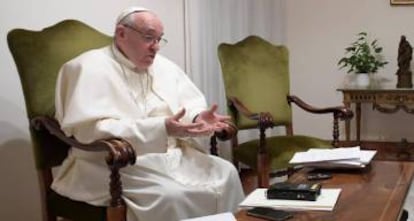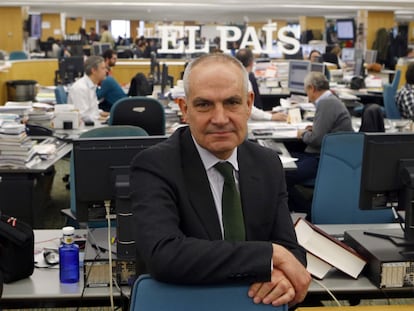In times of “fake news,” more readers than ever place their trust in EL PAÍS
For four consecutive years the newspaper has been the most-read publication in Spain and in the Spanish language

Last year saw EL PAÍS maintain its position as Spain’s leading newspaper for a fourth year in a row, becoming the Spanish-language publication with the largest online readership in the country, according to comsCore, a US market analysis company. In December, the newspaper website attracted 18,941,000 unique visitors in Spain – over 1.5 million more than its closest competitor El Mundo. With growth of 28.9% over the past 12 months, the newspaper has used the statistics from comsCore to calculate that it is one of the 10 most-read media outlets in the world, in any language.
EL PAÍS has the largest network of correspondents in Spanish media
But while 2017 was a year of growth, it also came with challenges. In November 2016, the Oxford Dictionary chose “post-truth” as the word of the year. With the arrival of Donald Trump in the White House and the advent of so-called “alternative facts,” EL PAÍS committed itself to reporting the truth about one of the most controversial administrations in US history. Drawing on the expertise of 10 journalists based across the United States and dozens more working from Mexico, the newspaper published a series of fact-checking articles on the presidency, creating a blog solely dedicated to verifiable news, christened Hechos.
Interview with the Pope
Just as Trump was being sworn in, EL PAÍS landed one of its biggest exclusives: an interview with the pope. During the more than hour-long interview, EL PAÍS editor-in-chief Antonio Caño and then-Rome correspondent Pablo Ordaz asked Pope Francis a broad range of questions. The answers were translated into various languages and quoted in media outlets across the world.

But this was not the only story to make an impact. EL PAÍS published many important articles in 2017, many of them written by its network of correspondents – the largest in Spanish-language media. From Morocco, the newspaper covered the last days of writer Juan Goytisolo before his death in June. The paper’s investigative team revealed exclusive details on the Odebrecht corruption case, which led to the arrest of many of involved, while also interviewing the lawyer accused of paying bribes to the presidents of 12 countries. From Mexico, the team provided minute-by-minute updates on the situation after two earthquakes devastated the country in September. From Brazil, dozens of journalists in charge of the Portuguese version of EL PAÍS covered the country’s political crisis direct from the streets of Rio.
In Argentina, EL PAÍS interviewed former president Cristina Fernández about the legislative elections. The newspaper’s correspondent in Silicon Valley kept readers informed on projects coming from companies behind the world’s biggest changes. Meanwhile, the Sports team launched the special investigation into the Villar case, the largest corruption case in the history of Spanish soccer.
Multimedia projects
EL PAÍS reached another milestone in March when it launched, together with four major European media outlets, The New Arrivals, a series of in-depth multimedia reports on the challenges faced by immigrants who arrive in the European Union. Journalists and camera crews traveled to Dakar in Senegal and the Melilla border fence between Morocco and Spain to capture personal stories as part of the ambitious project.
But the biggest news of 2017 was the Catalan independence drive. EL PAÍS coordinated teams between Madrid, Brussels and Barcelona, to bring the latest on the political crisis in the region. For four months running, the newspaper has maintained live updates on the situation as it unfolded minute by minute. This article has become the most read in the newspaper’s history since it went online.
During this period, EL PAÍS also reported on the fake news coming from Russia in support of the Catalan secessionists. EL PAÍS managing editor David Alandete presented these findings at a British parliamentary committee investigating fake news.
EL PAÍS is one of the 10 most-read media outlets in the world
EL PAÍS closed 2017 with a record-high readership but there are new challenges on the horizon. The newspaper wants to remain at the forefront of social change: to cover women’s fight for equality, to be the trusted source for news on the presidential elections in Mexico, Brazil and Colombia, to maintain a strong line on the crisis in Catalonia, to provide quick and engaging updates on the World Cup in Russia, and above all, to maintain the trust of millions of readers who consult the newspaper each day to learn about what’s really happening in a world clouded with fake news and half-baked truths.
English version by Melissa Kitson.
Tu suscripción se está usando en otro dispositivo
¿Quieres añadir otro usuario a tu suscripción?
Si continúas leyendo en este dispositivo, no se podrá leer en el otro.
FlechaTu suscripción se está usando en otro dispositivo y solo puedes acceder a EL PAÍS desde un dispositivo a la vez.
Si quieres compartir tu cuenta, cambia tu suscripción a la modalidad Premium, así podrás añadir otro usuario. Cada uno accederá con su propia cuenta de email, lo que os permitirá personalizar vuestra experiencia en EL PAÍS.
¿Tienes una suscripción de empresa? Accede aquí para contratar más cuentas.
En el caso de no saber quién está usando tu cuenta, te recomendamos cambiar tu contraseña aquí.
Si decides continuar compartiendo tu cuenta, este mensaje se mostrará en tu dispositivo y en el de la otra persona que está usando tu cuenta de forma indefinida, afectando a tu experiencia de lectura. Puedes consultar aquí los términos y condiciones de la suscripción digital.
More information
Archived In
Últimas noticias
Most viewed
- Sinaloa Cartel war is taking its toll on Los Chapitos
- Oona Chaplin: ‘I told James Cameron that I was living in a treehouse and starting a permaculture project with a friend’
- Reinhard Genzel, Nobel laureate in physics: ‘One-minute videos will never give you the truth’
- Why the price of coffee has skyrocketed: from Brazilian plantations to specialty coffee houses
- Silver prices are going crazy: This is what’s fueling the rally










































